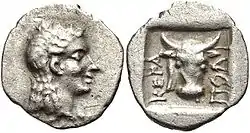Ceramus or Keramos (Ancient Greek: Κέραμος) is a city on the north coast of the Ceramic Gulf—named after this city—in ancient Caria, in southwest Asia Minor; its ruins can be found outside the modern village of Ören, Muğla Province, Turkey.[1]
History
Ceramus, initially subjected to Stratonicea, afterwards autonomous, was a member of the Athenian League and was one of the chief cities of the Chrysaorian League (Bulletin de corresp. hellén., IX, 468). It probably had a temple of Zeus Chrysaoreus. In Roman times, it coined its own money.
Polites (Ancient Greek: Πολίτης) of Ceramus was a famous runner who won three different races in the same day at the Olympia.[2][3][4]
Ecclesiastical history
Ceramus is mentioned in the Notitiae Episcopatuum until the 12th or 13th century as a bishopric suffragan to Aphrodisias, or Stauropolis. Three bishops are known: Spudasius (Σπουδάσιος), who attended the First Council of Ephesus in 431; Maurianus (Μαυριανός), who attended the Council of Nicaea in 787; and Symeon (Συμεών), who attended the council in Constantinople that reinstated Photius in 879.
Ceramus is included in the Catholic Church's list of titular sees.[5]
Ancient Coins
- Ancient Coins

 Coin depicting the god Zeus Chrysaoreus and an eagle, 1 AD - 2 AD.
Coin depicting the god Zeus Chrysaoreus and an eagle, 1 AD - 2 AD.
Gallery
%253B_r%C3%B6mische_Ruinen%252C_circa_1._bis_2._Jahrhundert_nach_Christus.jpg.webp) Roman ruins, approx. 1st to 2nd century AD.
Roman ruins, approx. 1st to 2nd century AD.%253B_r%C3%B6mische_Br%C3%BCcke_%C3%B6stlich_von_Keramos%253B_ca._1._bis_2._Jahrhundert_nach_Christus.jpg.webp) Roman bridge east of Keramos; approx. 1st to 2nd century AD.
Roman bridge east of Keramos; approx. 1st to 2nd century AD.%253B_griechische_Befestigungsanlagen_aus_vorchristlicher_Zeit.jpg.webp) Greek fortifications from pre-Christian times in the village of Ören,
Greek fortifications from pre-Christian times in the village of Ören,%253B_r%C3%B6misches_Viadukt%253B_ca._1._bis_2._Jahrhundert_nach_Christus.jpg.webp) Roman viaduct; approx. 1st to 2nd century AD near Ören,
Roman viaduct; approx. 1st to 2nd century AD near Ören,%252C_r%C3%B6m._Ruinen_von_Keramos.JPG.webp) Roman ruins in the north iof Keramos, approximative, 2nd century AD.
Roman ruins in the north iof Keramos, approximative, 2nd century AD.
References
- ↑ Richard Talbert, ed. (2000). Barrington Atlas of the Greek and Roman World. Princeton University Press. p. 61, and directory notes accompanying.
- ↑ Eusebius, Chronography, §80
- ↑ Pausanias, Description of Greece, 6.13.3
- ↑ Suda Encyclopedia, iota.572
- ↑ Annuario Pontificio 2013 (Libreria Editrice Vaticana, 2013, ISBN 978-88-209-9070-1), p. 866
External links
- Archaeological Atlas of the Aegean
- Catholic Encyclopedia, "Ceramus" at New Advent
- Hazlitt, Classical Gazetteer
![]() This article incorporates text from a publication now in the public domain: Herbermann, Charles, ed. (1913). Catholic Encyclopedia. New York: Robert Appleton Company.
This article incorporates text from a publication now in the public domain: Herbermann, Charles, ed. (1913). Catholic Encyclopedia. New York: Robert Appleton Company. {{cite encyclopedia}}: Missing or empty |title= (help)
37°02′33″N 27°57′05″E / 37.042418°N 27.951332°E